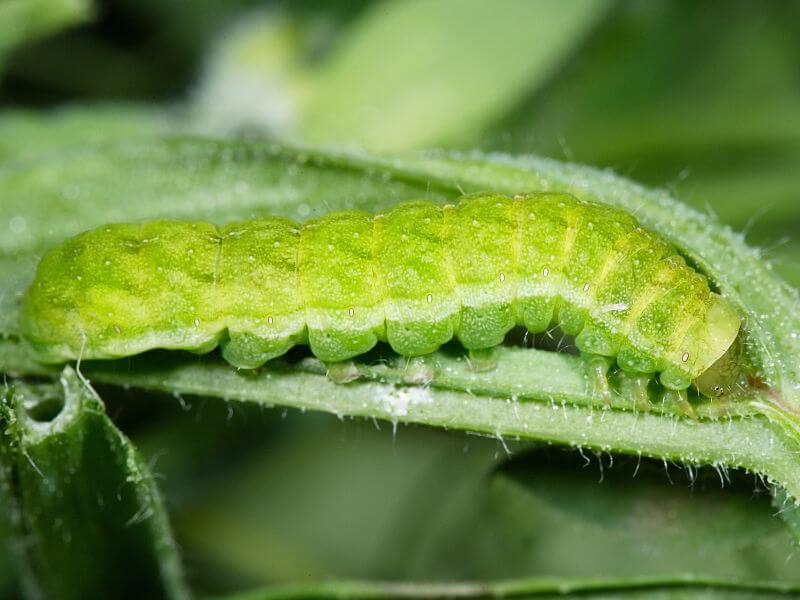Bright green caterpillars are fascinating. They are the youthful forms of butterflies and moths.
These caterpillars are known for their striking color. They blend into leaves, playing a crucial role in nature.
Their life cycle is amazing. From tiny eggs to beautiful butterflies or moths, their journey is remarkable.
In this article, we dive into their world. We’ll explore their habits, importance, and unique traits.
These caterpillars do more than just eat leaves. They’re key to the balance of ecosystems.
Let’s learn about bright green caterpillars and their role in our environment.
Understanding Caterpillars: Basics and Misconceptions
Caterpillars are more than future butterflies or moths. They’re a diverse group, and bright green caterpillars are particularly interesting. Many believe that caterpillars only eat and grow. But they do much more. They help plants by pollinating and enriching soil.
One common myth is about their eyes. Caterpillars don’t have 12 eyes like we think. They have six pairs of simple eyes, or ‘ocelli’. These eyes don’t see much detail. They mainly detect light and movement. Another misconception is their first meal. Not all caterpillars eat their eggshells. It varies by species. Some eat leaves right away.
Caterpillars change a lot as they grow. They molt several times. Each stage is called an ‘instar’. As they move through instars, they can look very different. This change is part of their survival strategy.
Many think all caterpillars are harmful to plants. It’s true they eat leaves. But they’re also part of the ecosystem. They’re food for birds and other wildlife. Their presence indicates a healthy environment.
Bright green caterpillars are especially misunderstood. Their color is not just for looks. It helps them hide from predators. They blend with leaves, staying safe from birds and other enemies.
Different Types of Bright Green Caterpillars
Green caterpillars are like monarch butterflies, beautiful and friendly. Green caterpillars eat various types of green leaves for nutrition and energy to grow and hatch into butterflies. Just like any other species, there are various kinds of green caterpillars. Let’s get a glimpse into the various kinds and learn a little more about them.
1. Tomato Hornworm Caterpillar
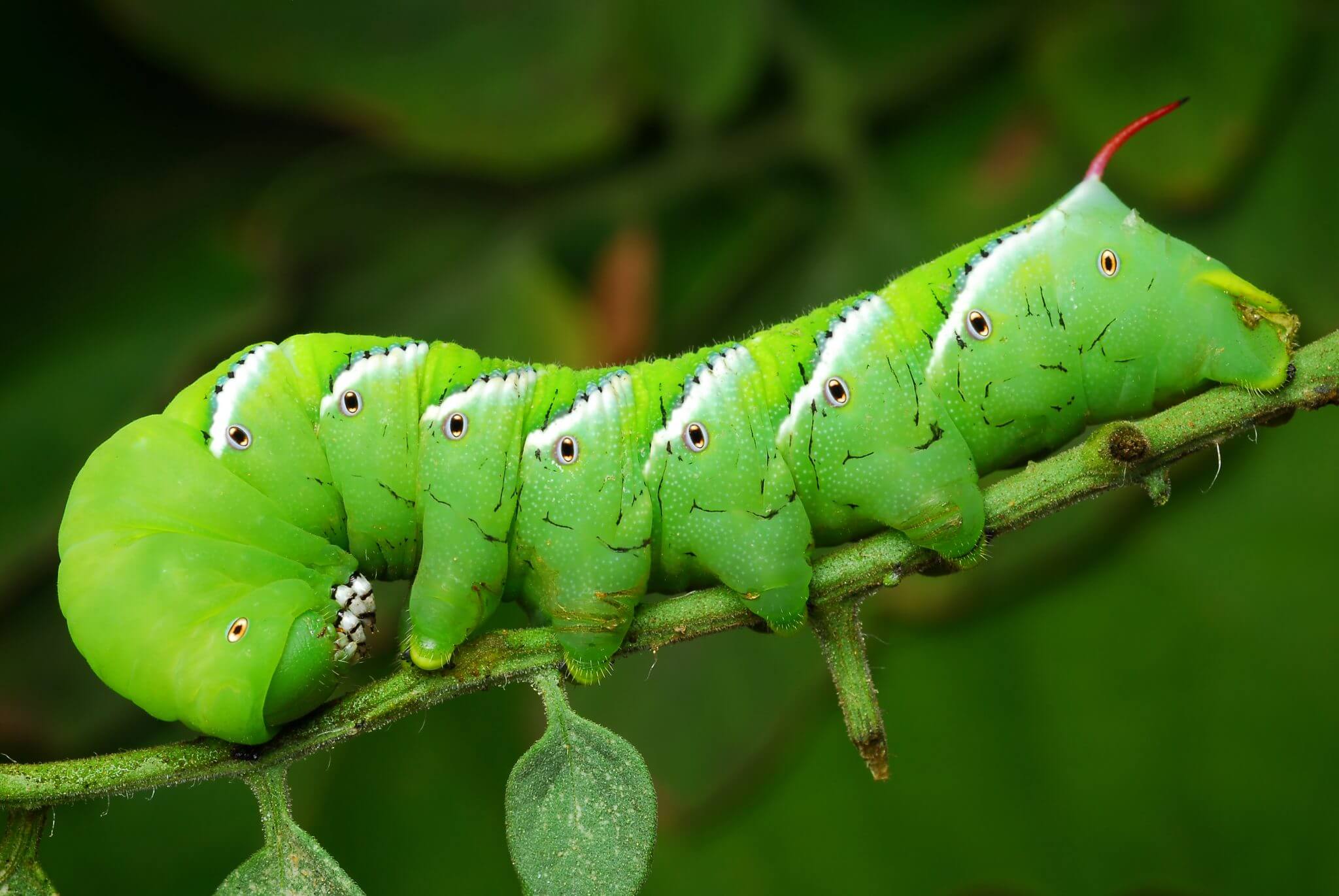
Manduca quinquemaculata is one of the most stunning caterpillars people have seen in their own gardens or nurseries. The Tomato Hornworm Caterpillar lives off a diet of tomato plant leaves, vines, and fruit – hence its name.
You could identify this species of green caterpillar even if you saw it from a mile away. The Tomato Hornworm Caterpillar has a tell-tale horn (or spike) shaped ‘protruding tail!’ This green caterpillar species does nothing but slither and eat your tomato plants – it does not bite or sting as some other insects do.
These caterpillars eat ‘like there is no tomorrow!’ However, do not think you can get rid of them with a single spray of harmless pesticides. The Tomato Hornworm Caterpillar is complicated for the untrained eye to spot.
You are most likely to encounter this green caterpillar species if you live in the Northern part of America or the Southern part of Canada.
2. Winter Moth Caterpillar A.K.A. inchworm
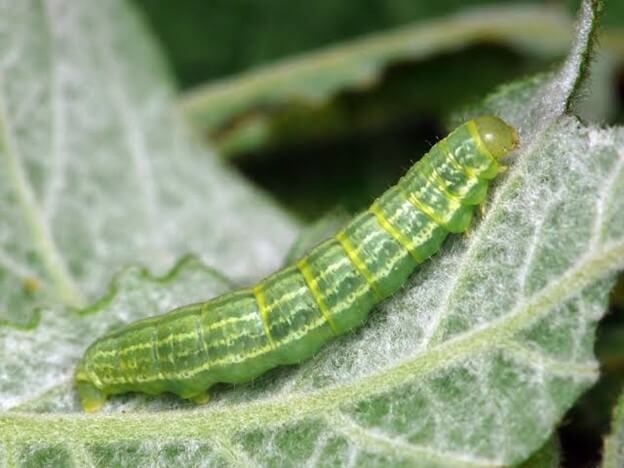
The scientific name for the Winter Moth Caterpillar is the Operophtera Brumata. It gets its name from the family and the genus it belongs to, the Operopthera and the Brumata. It will most likely only be one inch long. This species of inchworm is the odd man out in terms of utility. A tell-tale feature of this species of green caterpillar includes two pairs of green legs towards its posterior and its horizontal white stripes.
Typical food for the inchworm includes oak, maple, willow, and beech tree leaves. This species of green caterpillar will eat the leaves of any tree that grows. It also feeds on raspberry and blueberry shrubs.
3. Genista Broom Moth Caterpillar
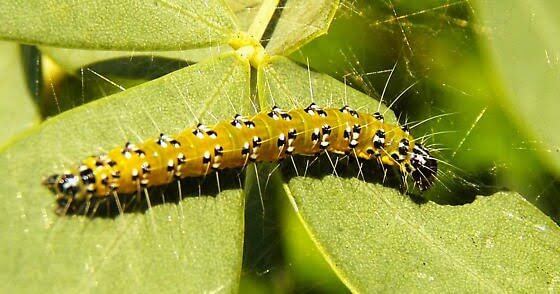
This green caterpillar belongs to the Uresiphita Reversalis species. You can tell it apart from other green caterpillars by its raised black and white dots. The Genista broom moth caterpillar is brownish-green in colour with a black head. Finally, its body is separated into different sections which are characterized by white, black, and yellow spots.
This species of green caterpillar has another distinct feature – protruding white wispy spines. Its food source consists of sweet peas, honeysuckle (and their plants), and other types of plants that grow fruit, vegetables, and leaves.
4. Black Swallowtail Butterfly Caterpillar
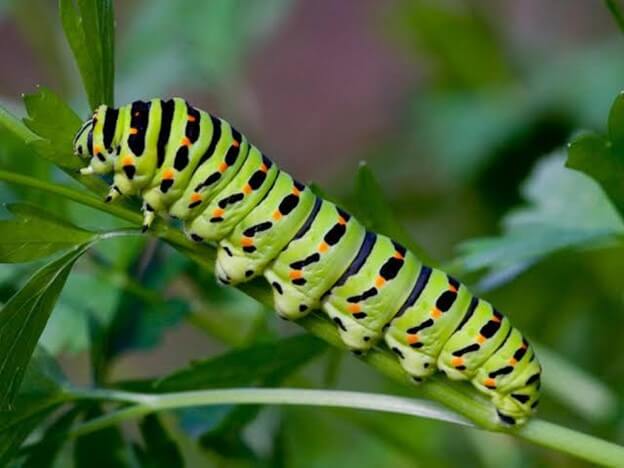
The Papilio Polyxenes, commonly known as the green caterpillar, possesses several distinctive features. Its body is a striking lime-green color, adorned with noticeable black spots and yellow dots along the black stripes. An interesting defense mechanism of this species is the emission of a terrible fragrance. When threatened, the caterpillar displays yellow horns which protrude from its head. Additionally, its body is relatively fatter and wider compared to other species.
Another unique characteristic is its ‘orange’ tongue, which is fork-shaped and protrudes when the caterpillar is attacked or provoked. The spacing of the stripes and dots on the caterpillar’s body is closer together at the front.
One of the most intriguing aspects of this species is the appearance of its larvae, which remarkably resemble blackbird droppings.
5. Emperor Moth Caterpillar
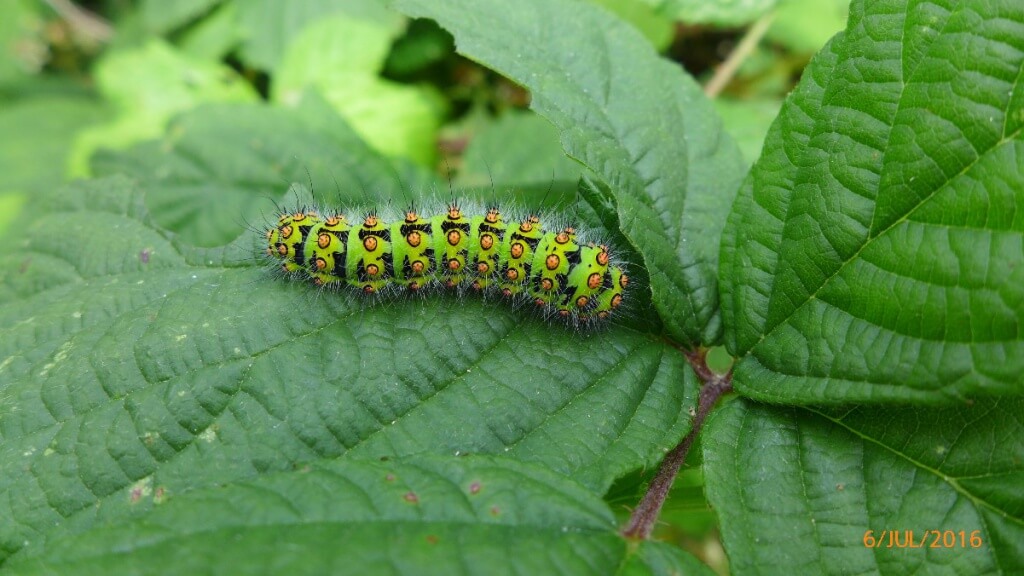
The Emperor Moth Caterpillar, scientifically named Saturnia Pavonia, is a prominent member of the Saturniidae insect family. This large caterpillar undergoes significant color changes throughout its development. Initially, in the larval stage, it displays a striking black and orange coloration. As it matures, the caterpillar transforms into a vibrant green.
One of its most distinctive features is the horizontal rows of bushy orange and yellow spots, each encircled by distinct black rings. The caterpillar is also known for its stiff and sharp spines. Although these spines are not poisonous, they can still cause skin irritations such as cuts, scratches, and rashes, making the Emperor Moth Caterpillar a species to approach with caution.
6. Tiger Swallowtail Butterfly Caterpillar
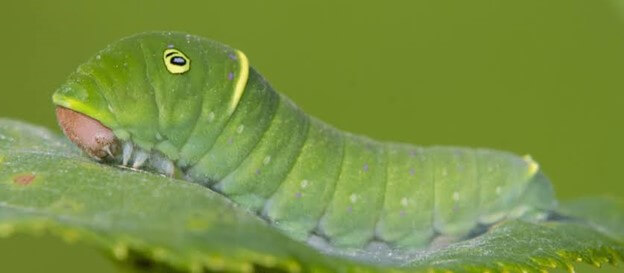
Tiger Swallowtail Butterfly Caterpillar (Papilio glaucus): This green caterpillar, a member of the Papilionidae family, is notable for its unique markings. Its distinctive features include eye-like markings on its head, with green or yellow dots and black cores and white or yellow bands behind its head. Prior to cocooning, the caterpillar changes to a dark brown color. When threatened or provoked, it emits a foul odor and protrudes a ‘tongue-like’ organ, making it easily recognizable even from a distance.
7. Polyphemus Moth Caterpillar
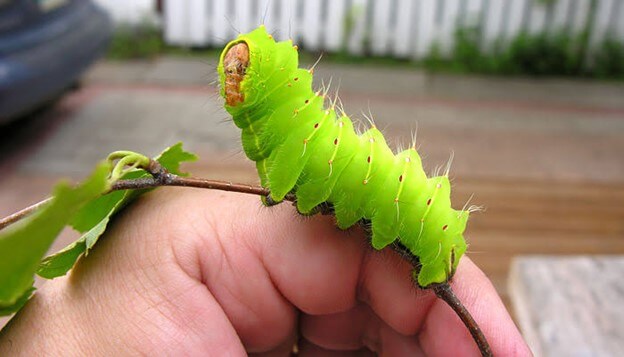
These green caterpillars are bright yellow in color at birth and later become bright green when spinning inside the cocoon. This species of green caterpillars can grow up to four inches in length.
They are born when spring begins and spin their cocoons as summer draws to a close. They emerge as moths whose wings can grow up to 5 and a half inches long. You will see this species of green caterpillar a lot if you live in North America.
8. Luna Moth Caterpillar
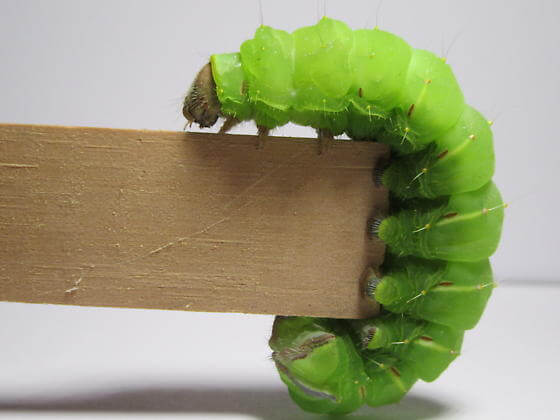
You can identify this species of green caterpillar by many unique and distinct features. Vibrant lime-green body. Red dots appear throughout the body. This species belongs to the Saturniid family.
The caterpillars molt five times before finally spinning their cocoons. They can grow up to two and three-fourths inches long and have wings that are up to 4 and a half inches long. The larvae and green caterpillars feed on maple, birch, beech, oak, lemon, lime, and other citrus trees.
9. White-lined Sphinx Moth Caterpillar
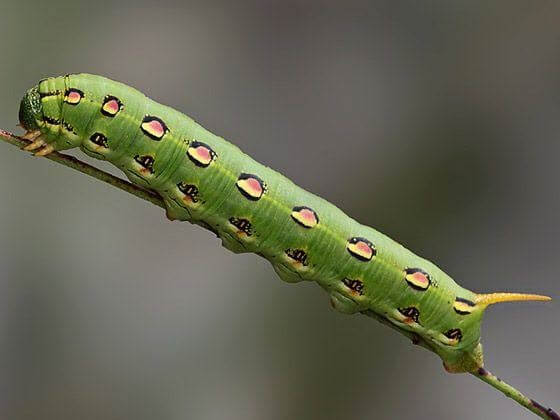
White-lined Sphinx Moth Caterpillar (Hyles lineata): Belonging to the hornworm family, this caterpillar is distinguished by its lime-green body and horizontal black and yellow markings. Variations within the species include individuals with green bodies featuring orange and yellow spots.
A prominent identifying feature is the horn at the end of its tail, which is harmless and cannot poke. Each black marking on its body is round, surrounded by yellow rings, and its back legs are adorned with white-speckled black and yellow dots.
10. Copper Underwing Moth Caterpillar
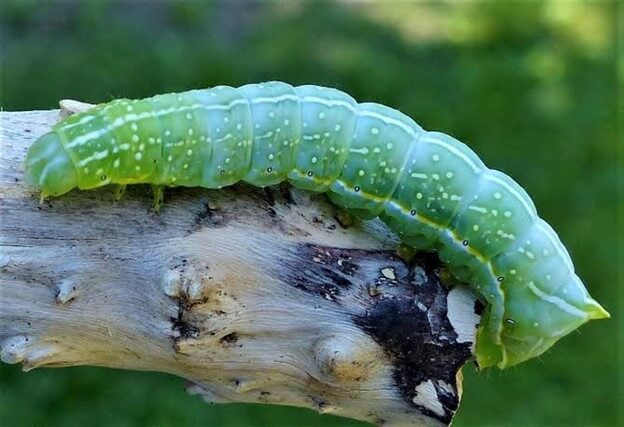
Known by its scientific name, Amphipyra pyramidoides, copper underwing moth caterpillar hatches into a moth. Even thought it seems like it belongs to the hornworm family at first glance, it is not true. It does have certain unique features that distinguish it from the rest, which include:
- The copper underwing moth caterpillar has a hornless hump on its end.
- The copper underwing moth caterpillar is born with a translucent, neon green color.
- The copper underwing moth caterpillar’s color will darken as it matures and eats greener leaves and plants.
- You will see a thin yellow line on its side as this green caterpillar species feeds and grows.
- This species of green caterpillar often sits upright even when resting.
- The copper underwing moth caterpillar can grow up to 3 and a half inches long.
The copper underwing moth caterpillar lives off a diet of leaves from raspberry, oak, maple, and apple trees.
11. Cabbage White Butterfly Caterpillar
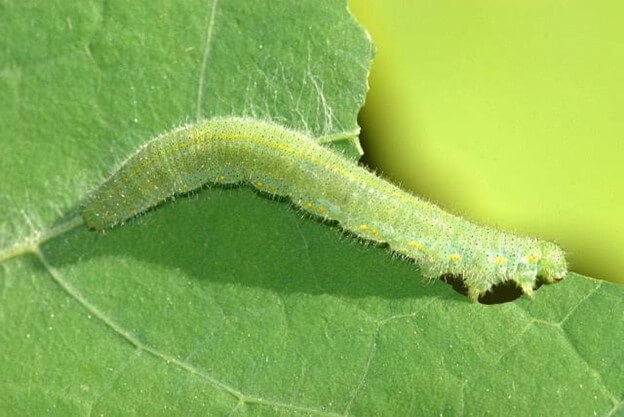
The Cabbage White Butterfly Caterpillar, a member of the Pieris rapae species, is a common sight in natural environments. It’s characterized by a long, thin body with a distinctive green color, interspersed with yellow markings. The caterpillar’s body appears slightly fuzzy. A notable feature of this species is its voracious appetite for leaves, contributing to its rapid growth.
As a result, these caterpillars are always in search of food. Their invasive nature means they can swiftly populate and potentially overrun gardens or natural landscapes within a week. Some in this species display a bluish-green body adorned with black raised polka dots. The larvae of this species initially have blackheads, which transition to yellow and eventually green as they mature.
12. Hickory Horned Devil Moth Caterpillar
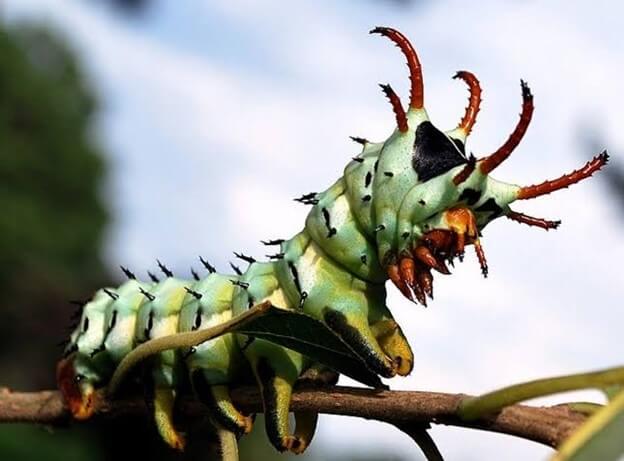
The Hickory Horned Devil Moth Caterpillar, or Citheronia regalis, is an imposing green caterpillar. Its remarkable features include a blue-green color and large size, often growing up to six inches. It’s characterized by horizontally protruding black spikes and distinct long, spiky red horns with black tips.
The caterpillar’s front and rear are marked with red tips. Despite its fierce appearance, this species is harmless, as it neither stings nor bites. Its unique appearance certainly makes it stand out from other green caterpillars.
13. Rustic Sphinx Moth Caterpillar
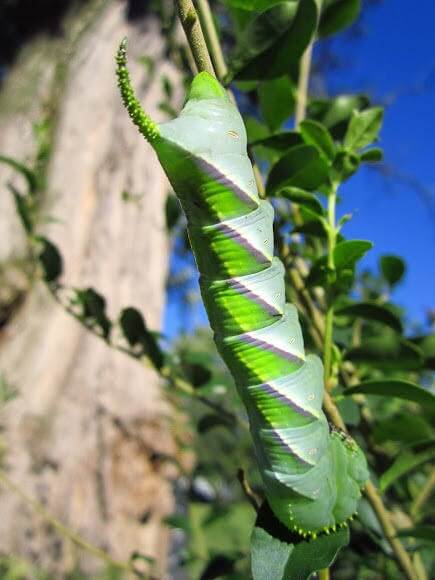
The Rustic Sphinx Moth caterpillar, scientifically known as Manduca Rustica, is commonly found in the southern United States, especially in Texas, Florida, South Carolina, and Mississippi. This green caterpillar is identifiable by several distinctive features.
It sports a horn on top of its head and has a long, lime-green body. The caterpillar is marked by unique horizontal stripes in white and maroon, creating a striking pattern. At its rear, it has a non-stinging spiny horn, often a point of interest for observers. The caterpillars are known for their red heads, which contrast with their green bodies.
Additionally, diagonal white stripes run along the body, acting as section dividers. Interestingly, some of these caterpillars have horny tails adorned with yellow or red freckles. A notable characteristic is their posture, which resembles the great Sphinx of Egypt when they stand up.
14. European Puss Moth Caterpillar
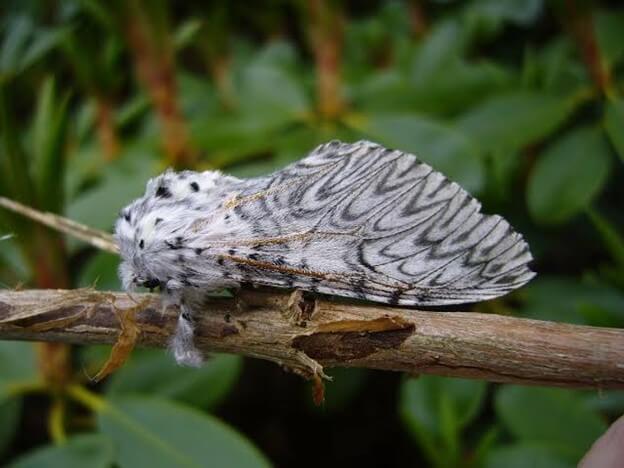
The European Puss Moth Caterpillar, a member of the Cerura Vinula species, is easily identified by its triangular head and long, spiked tail. It has an intriguing defense mechanism involving long red lashes that deter predators. This species is also known for its unique face, reminiscent of classic insect alien imagery.
Contrary to some exaggerated claims, this caterpillar doesn’t have teeth or spit toxic acid. It exhibits a notable behavior of wagging its tail when agitated. This green caterpillar can grow up to 3 inches in length.
15. Cecropia Moth Caterpillar
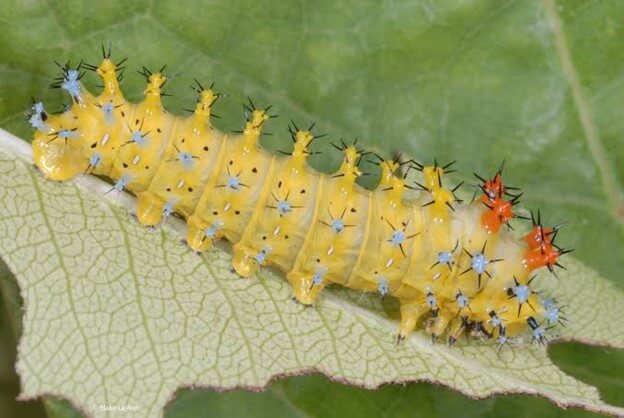
This particular green caterpillar is renowned for its impressive size and remarkable transformation. Its life cycle includes a striking change from a yellow-green larvae to a mature caterpillar with a blue-green hue. This dramatic metamorphosis sets it apart as a unique species.
In addition to its color transformation, this caterpillar is characterized by rigid and spiked sections along its body. The presence of tubercules in shades of yellow, blue, or orange further distinguishes it. These tubercules are adorned with small black spikes. Notably, the caterpillar can attain a substantial size, growing up to 4.5 inches in length, which contributes to its standout appearance in the caterpillar world.
16. Angle Shades Moth Caterpillar
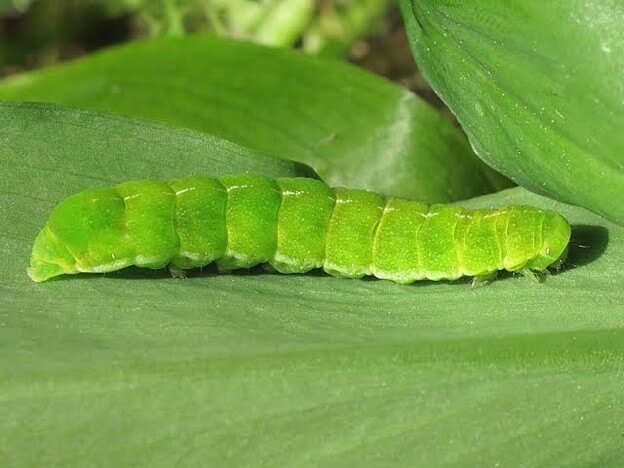
The Angle Shades Moth Caterpillar, classified under the species Phlogophora meticulosa, is a member of the Noctuidae family. This green caterpillar can be distinguished from others by its small larvae and dull green color. A notable feature is the presence of white dorsal lines across its body.
Interestingly, there is some variation in the appearance of these caterpillars. While typically green or brown, some individuals exhibit bodies polka-dotted with red spots, adding to their unique identification characteristics.
17. Cabbage Looper Caterpillars
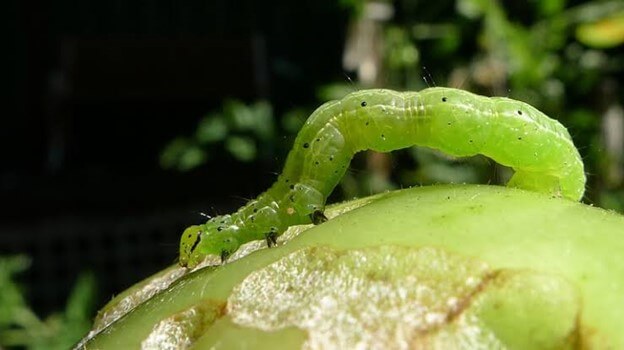
The Cabbage Looper Caterpillar, scientifically known as Trichoplusia ni, is distinguished by several unique characteristics that set it apart from other green caterpillars. Notably, it exhibits an arched crawling motion and has a hairy exterior. As the larvae mature, they develop a greener coloration.
These caterpillars are known for their voracious appetites, capable of consuming up to three times their body weight in a single day. In terms of size, they can grow up to 1.5 inches in length.
The Meaning and Historical Significance of Green Caterpillars
Green caterpillars are beautiful. Maybe that is why they have had a special place in history and literature throughout the ages. This section is for you if you are interested in understanding the meaning and significance of green caterpillars.
The Symbolic Meaning of Green Caterpillars
Do not be angry if you see a green caterpillar in your garden. It can mean that good luck and fortune is around the corner. Caterpillars, and especially green ones, symbolize good potential and transformation in life. The reason is that caterpillars enter a new stage of life when they spin their cocoons and transform into butterflies or moths.
Green caterpillars also symbolize new and emerging horizons in your life. It can also mean that you are about to experience a sudden burst of creative inspiration and thoughts. If you see a green caterpillar, you should know that good change is about to occur in your life.
Since green caterpillars also symbolize a person’s ability to forget about past traumatic events and move on, they reflect a person’s personality. Chances are you have a strong personality with the ability to forgive people and ‘bounce back from any situation, no matter how traumatic!
People have valued green caterpillars and the moths and butterflies that they hatch into throughout history. Maybe, therefore, caterpillars, and especially green caterpillars, are mentioned throughout history.
Are Green Caterpillars Bad for Your Garden?
You may think that all species of caterpillars will damage your garden or nursery, and this is especially true of green caterpillars. These types of caterpillars have a penchant for chowing down on the leaves and flowers of cauliflower, Brussel sprouts, and broccoli plants.
While they are annoying for you, they can be a bane for farmers and other agricultural firms because they can destroy millions of dollars of good produce in a few weeks!
How Do You Drive These Green Caterpillars Away from Your Garden?
You will see them most often during the spring, summer, and autumn months. However, do not assume that they are dormant during the wintertime because this is not true. Since green caterpillars are a year-round bane, you should know how to rid your lawn, nursery, and garden of them.
You know that you have green caterpillars in your garden if you spot lots of the following:
- Lots of green leaves that have holes in them.
- Caterpillar poop on the bottoms of the leaves. In case you were wondering, these have a blue-green color.
Of course, you could always use a store-bought brand of pesticide, but this has many negative consequences. One of the main ones being that you will continuously be spraying your plants and growing vegetables with potent poisons.
These can make you very sick or even kill you. This is true even if you only eat the residue on the vegetables – it is impossible to wash all the pesticides off the vegetables no matter how intensively or how many times you wash them.
Use Your Hands
This may sound strange, but it is entirely possible to remove green caterpillars from your garden, nursery, or lawn with your hands. Once you have plucked them off the leaves, you can either kill them or isolate them in your compost heap.
Believe it or not, this is one of the most effective ways to get rid of green caterpillars. What is even better is that it is entirely safe because it is entirely natural.
Introduce A Species of Insect That Will Eat the Green Caterpillars
Believe it or not, many species of insects will happily munch away at green caterpillars while leaving your plants completely intact. If you are lucky, you can import them from local sources.
If this is not an option, hop online and look for websites that sell these insects. Yes, these websites exist, and they will even drop the insects off your doorstep – thanks to contactless delivery that’s COVID-inspired.
Spray Your Plants with Harmless Chemicals
While it may seem strange that harmless chemicals exist, it was a bit of an exaggeration. The chemicals will not harm your plants, but they are toxic for green caterpillars. You can buy them from specialized websites. Look for products that have Bacillus thuringiensis in them. This is a bacterium that is deadly for green caterpillars.
Keep in mind that you will have to use it for a few days to be effective. The reason why is that it is natural and does not contain any vital ingredients.
Wrapping Up
Ants and aphids are a natural part of life. The same is true for green caterpillars. As you saw by reading this article, there are many different species and types of these caterpillars. They have a haunting beauty.
Maybe that is why they have a special place in literature. They have also had a place in history. So, the next time you see a green caterpillar, you know that you should admire, respect, and enjoy these green beauties. However, be sure to do so in nature and not in your garden or nursery.

